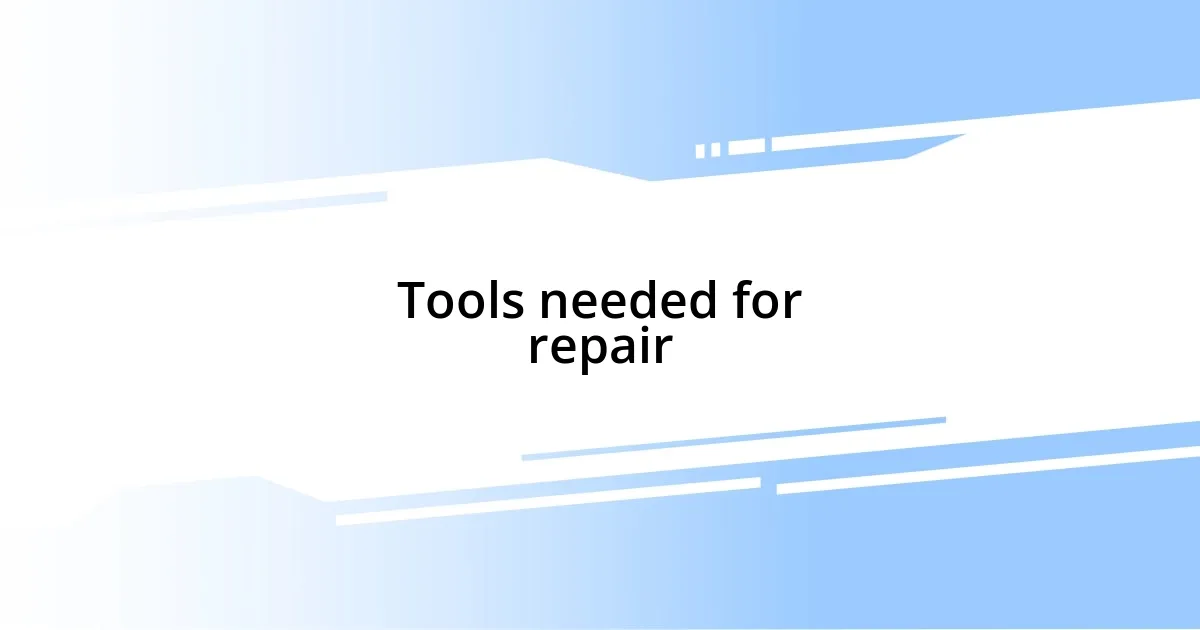Key takeaways:
- Understanding toilet tank components, like the flapper and water level, helps prevent common issues and simplifies repairs.
- Common toilet tank problems include leaks, running toilets, weak flushes, and noisy tanks, often having simple fixes.
- Having the right tools, such as a crescent wrench and toilet repair kit, is essential for effective repairs.
- Regular preventative maintenance can mitigate potential issues, such as inspecting for cracks and replacing rubber components periodically.

Understanding toilet tank components
When I first opened up a toilet tank, I was hit with a mix of confusion and curiosity. The tank is a collection of components, each with a specific role to play in making sure your toilet operates smoothly. There’s the flush valve, which releases water into the bowl, and the fill valve, which refills the tank after flushing – understanding their functions can prevent a lot of headaches.
One component that often surprises people is the flapper. This little rubber disk is crucial; it controls the water flow from the tank to the bowl. I remember a time when I dealt with a constantly running toilet, and it turned out the flapper was just worn out. Have you ever encountered a problem that seemed bigger than it was? Sometimes, a simple replacement can save you both time and money.
Lastly, the tank’s water level is vital for efficient flushing. If it’s too low, you may find yourself doing multiple flushes, which can be frustrating. It’s fascinating how a small adjustment can make such a big difference. I’ve learned that understanding these components isn’t just about repair—it’s often about making your life easier and your home more efficient.

Common toilet tank issues
Toilet tanks can be a source of frustration when things go awry. From my experiences, certain issues tend to crop up regularly. Remember the last time I walked into a bathroom only to hear an unsettling gurgling noise? It turned out the fill valve was malfunctioning. Such common hiccups might seem minor, but they can truly disrupt the comfort of your home.
Here’s a quick rundown of common toilet tank issues I often encounter:
– Leaking tank: This can often lead to water pooling around the base. The culprit is usually a faulty gasket or cracked tank.
– Running toilet: A constant sound of water can indicate a worn flapper or improperly adjusted float.
– Weak flush: When the toilet doesn’t clear waste effectively, it might point to a clogged rim jet or a low water level.
– Tank won’t refill: I once dealt with this when the fill valve was stuck, which made for some awkward bathroom moments!
– Noisy tank: If you hear banging during the refill, it might be due to a pressure issue, commonly referred to as “water hammer.”
Each of these issues can be annoying, but they often have simple fixes!

Tools needed for repair
When tackling toilet tank repairs, having the right tools on hand makes all the difference. I remember the first time I attempted a repair without my essential toolkit. It was a mess! Basic tools like a crescent wrench and a flathead screwdriver are key for loosening and tightening components. A pair of pliers can also be handy, especially when dealing with stubborn nuts or bolts that just won’t budge. Trust me, don’t skip on these basics; they’re your best friends during a repair!
Additionally, if you’re thinking about making adjustments to the float mechanism, a level might come in useful. Balancing water levels can sometimes feel like trying to find the sweet spot in a game of Jenga – too high, and you create a leak, too low, and nothing flushes right. During one of my repairs, I felt a wave of relief when I could finally get everything dialed in just right. A small level gave me that confidence!
Lastly, investing in a toilet repair kit can save you both time and hassle. These kits often include flappers, washers, and gaskets tailored for a variety of tank designs. The first time I opened one, I was pleasantly surprised by the assortment—like a treasure chest of repair magic! If you’re serious about maintaining your toilet, consider having one of these kits nearby. It’s amazing how having the right tools at your disposal can turn what seems like a daunting task into an easy fix.
| Tool | Purpose |
|---|---|
| Crescent Wrench | To tighten or loosen fittings |
| Pliers | To grip or turn stubborn components |
| Flathead Screwdriver | To adjust screws on the tank mechanism |
| Level | To ensure proper float adjustment |
| Toilet Repair Kit | Contains various essential parts for repairs |

Step by step repair process
The first step in repairing a toilet tank is to turn off the water supply. I’ll never forget the time I forgot this crucial part – my bathroom turned into a mini splash zone! Once the water is off, I usually drain the tank by flushing. This prevents any mess when you start working inside. With the tank empty, I take a good look at the internal components, assessing what needs fixing.
Next, I focus on identifying the specific problem. For instance, if the toilet is leaking, I wiggle the bolts that hold the tank to the bowl. If they feel loose, I tighten them gently. I recall a moment when I thought I’d have to completely replace my tank, but after a little tightening, I was amazed to find the leak simply stopped. But if the condition persists, I swap out the gasket, which can often be the issue, and keeping a few extras on hand has saved me more than once.
Finally, I reassemble everything carefully, ensuring that each part is snug but not over-tightened. I always take a moment to step back and double-check my work. What if I missed something? After letting the tank refill, watching for leaks feels like waiting for a magic show to end. The relief I feel when everything operates smoothly is priceless. Then, I take a moment to admire my handiwork—doesn’t it just feel good to fix things yourself?

Testing the toilet tank
Once I had tackled the initial setup, I went on to test the toilet tank. It may seem simple, but I can’t stress enough the importance of this step. After reassembling, I carefully turned the water supply back on and watched—the anticipation was palpable. Would everything work as planned? Seeing the tank refill smoothly was like a sigh of relief. Sometimes, it’s just those little moments that remind me why I enjoy DIY repairs.
I often test the flapper and the flush mechanism right after the tank fills. It’s fascinating how a small component can have such a big impact. I clearly remember a time when I was feeling cocky about my repair skills, only to find that the flapper wasn’t sealing properly. It led to this annoying, continuous running sound. I felt a bit defeated, but I quickly popped the lid off and made the adjustment. That moment taught me the value of patience and thoroughness—essential traits in any home repair.
Then there’s the water level to consider. I keep a keen eye on it, making sure it’s at the right height. A mistake here can lead to overflow, ruining all that hard work. I’ve experienced the horror of opening the bathroom door to find a small flood. Let me tell you—testing every aspect of the tank system has become a non-negotiable for me since then. It’s a solid reminder that this seemingly mundane task can lead to unexpected surprises, both good and bad.

Preventative maintenance tips
Preventative maintenance is key to avoiding those dreaded emergency repairs. I remember once, during a routine check, I discovered mineral buildup around the flapper. It was like finding a hidden treasure – a little cleaning here saved me from a potential leak later. Regularly inspecting and cleaning the internal components can save you a lot of hassle down the line. Who wants to deal with a malfunctioning toilet in the middle of the night, right?
I always keep a checklist of things to look for during each maintenance session. Checking the tank for any cracks or corrosion can help catch issues before they escalate. Once, I found a small crack I nearly overlooked, which, if left untreated, would have led to a costly water bill. It’s astonishing how both vigilant eyes and a simple checklist can make such a difference.
Another tip I swear by is to replace the rubber components every few years. It might seem like a tedious task, but I learned my lesson when a worn-out flapper caused my toilet to run continuously. The sound was unbearable! Now, I view it as a minor investment in my peace of mind. Setting reminders for these small tasks has helped me maintain my toilet’s performance, and I sleep soundly knowing I’ve mitigated potential problems. Isn’t it nice to feel proactive rather than reactive?

When to call a professional
When you’ve done all you can and the tank still leaks, it might be time to consider calling a professional. I recall a situation where despite my best efforts, the problem persisted. That feeling of helplessness made me realize that sometimes, our DIY limits are just that—limits. It’s okay to admit when something is beyond our skill level.
Another instance that comes to mind is when I attempted to replace the fill valve. I thought I was on the right track, but the water pressure issues I ended up facing were beyond my control. If you’re encountering strange noises or inconsistent flushing after your repairs, it’s likely a signal that a plumber’s expertise is needed. Isn’t it better to seek help rather than risk further damage?
If you’re feeling overwhelmed or unsure about the necessary repairs, don’t hesitate to pick up the phone. I remember postponing a decision to call for help, thinking I could handle it. The recursive cycle of frustration only delayed a simple fix. Trust your instincts; sometimes, it’s best to leave it to the pros for peace of mind.














